
West Overton is located approximately 40 miles (64 km) southeast of Pittsburgh, in East Huntingdon Township, Westmoreland County, Pennsylvania, United States. It is on PA 819 between the towns of Mount Pleasant and Scottdale. Its latitude is 40.117N and its longitude is -79.564W.

Sugartown is an unincorporated settlement in central Willistown Township, Chester County, Pennsylvania, United States, at the intersection of Sugartown and Boot Roads. It is located 18 miles west of Philadelphia.

Virginville is a census-designated place in Richmond Township, Berks County, Pennsylvania. It is located at the junction of PA 143 and Crystal Ridge Road, and is approximately 7 miles to the south of the borough of Lenhartsville.
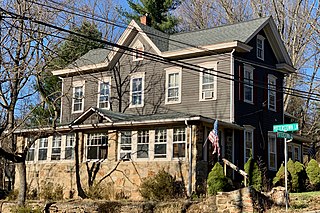
Potterstown is an unincorporated community along the border of Clinton and Readington townships in Hunterdon County, New Jersey.
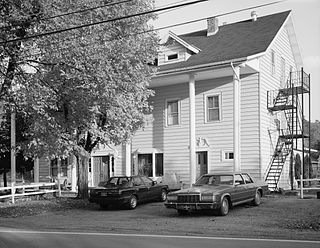
Robertsdale Historic District is a national historic district located at Robertsdale in Wood Township, Huntingdon County, Pennsylvania. The district includes 102 contributing buildings and 1 contributing site. The buildings primarily date between about 1873 and the 1920s and are associated with the development of the company town by the Rockhill Iron and Coal Company. They include the company office, store, and railway depot, along with workers' housing. Notable buildings include the company store (1873-1874), Rockhill Iron and Coal Company office building (1914), Robertsdale Post Office, East Broad Top Railroad depot (1914), Robertsdale Hotel, Reality Theatre (1948), McClain Store (1911-1923), superintendent's house (1896), Methodist Parsonage (1922), Wood Township Elementary School (1934), and the Methodist Episcopal Church (1890s).
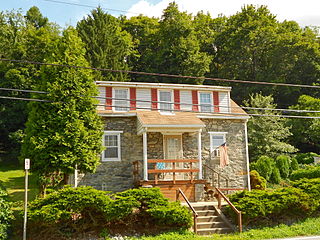
Pleasureville Historic District is a national historic district located at Springettsbury Township in York County, Pennsylvania. The district includes 105 contributing buildings and one contributing site in the crossroad community of Pleasureville. Most of the buildings are residential include 19th century vernacular dwellings with notable examples of early 20th century Colonial Revival and Italianate style dwellings. Notable non-residential buildings include a former schoolhouse, meeting hall, former store and accessory shop, and small industrial shop. The contributing site is the Pleasureville Cemetery with 72 marked graves dating between 1865 and 1929.
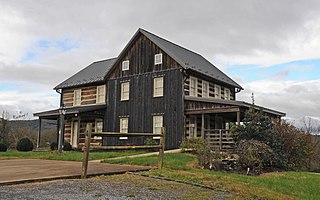
Rock Hill Farm, also known as the Davis-Stauffer Farm Complex, is a historic home and farm and national historic district located at Montgomery Township in Franklin County, Pennsylvania. The district includes 12 contributing buildings, 2 contributing sites, and 3 contributing structures. They are associated with three areas: the Davis-Chamber farmstead, Eliab Negley House, and Joseph Negley farmstead. Contributing components of the Davis-Chamber farmstead include the log and frame main house, 18th century log smokehouse, limestone milk house, frame wash house, frame outhouse, frame wagon shed, and a frame barn with concrete sile. The property also includes a stone wall, and the archaeological remains of earlier buildings including a limestone mill dismantled about 1930. The Eliab Negley House is a log dwelling built between 1810 and 1823. The Joseph Negley farmstead includes a Greek Revival-style dwelling built between 1836 and 1850, with later modifications about 1900. Also on the property are a contributing 19th century smokehouse, a frame wagon shed, and a large shed.

Andrews Bridge Historic District is a national historic district located at Colerain Township, Lancaster County, Pennsylvania. The district includes nine contributing buildings in the rural crossroads village of Andrews Bridge. The buildings were built between 1800 and 1850 and are the old Roop's Hotel, a former mill also known as Dobbin's Store, four dwellings, and three barns.

Tamaqua Historic District is a national historic district located at Schuylkill Township and Tamaqua, Schuylkill County, Pennsylvania. The district includes 944 contributing buildings, 3 contributing sites, 8 contributing structures, and 3 contributing objects in the central business district and surrounding residential areas of Tamaqua. The residential buildings principally date to the early 20th century. They are mostly two-story, of brick and frame construction, and in a variety of popular architectural styles including Queen Anne, Late Victorian, Italianate, and Colonial Revival. Notable non-residential buildings include the Little Schuylkill Hotel (1827), White Swan, Washington House, Shepp Building, Elks Lodge, Peoples Trust Company Building, Tamaqua National Bank (1908), First National Bank of Tamaqua, U.S. Post Office (1932), Majestic Theater and Hotel, Hegarty Blacksmith Shop (1848), Conrad Biscoff Planing Mill and Furniture Factory (1865), Tamaqua Manufacturing Company (1910), Calvary Episcopal Church (1851), First Methodist Church (1852), St. Jerome's Roman Catholic Church (1856), American Hose Company (1881), East End Fire Co. (1923), and the former Tamaqua Armory. The contributing sites are St. Jerome's Cemetery, Odd Fellows Cemetery (1865), and the foundation of the Fitzpatrick Shirt Factory (1888). Contributing structures include three runs of iron steps and five bridges. Located in the district and separately listed are the Anthracite Bank Building, George Ormrod House, and Tamaqua Railroad Station.
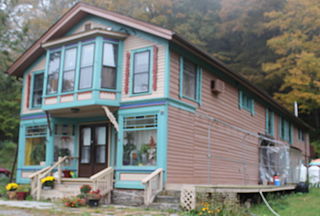
Damascus Historic District, is a national historic district located at Damascus Township, Wayne County, Pennsylvania. The district includes 36 contributing buildings, 2 contributing sites, and 2 contributing structures in the community of Damascus. The buildings are in a variety of popular architectural styles including Greek Revival, Queen Anne, and Renaissance Revival. Notable buildings include the Baptist Church, Damascus Academy, Vail and Appley Store, Methodist Church (1857), Philip O'Reilly House, and Luther Appley House. The sites are the Hillside Cemetery and Overlook Cemetery.

Milanville Historic District, is a national historic district located at Damascus Township, Wayne County, Pennsylvania. The district includes 17 contributing buildings in the community of Milanville. The buildings were built between 1850 and 1910, and are vernacular interpretations of a variety of popular architectural styles including Greek Revival and Queen Anne. Notable buildings include the Phone Company Building, Milanville Store, Milanville School, Volney Skinner House, Weston Skinner House, Frank Davis House, Milton Skinner House, Nathan Skinner House (1815), and Milanville Methodist Church (1910). The Milanville-Skinners Falls Bridge is located in the district.

Mount Pleasant Historic District is a national historic district located at Mount Pleasant, Westmoreland County, Pennsylvania. It encompasses 268 contributing buildings, 1 contributing site, and 1 contributing object in the central business district and surrounding residential areas of Mount Pleasant. They were built between about 1812 and 1948, and includes a mix of residential, commercial, institutional, and industrial properties. They are in a variety of popular architectural styles including Italianate, Queen Anne, and Colonial Revival. Notable buildings include the Overholt General Store, harness shop, warehouse, East End Hotel, Grand Central Hotel, Gerechter Furniture Building, Citizens Savings and Trust Company and First National Bank (1905), Shupe Steam Grist Mill (1843), City Hall (1910), Penn Theater (1937), Reunion Presbyterian Church (1873), Wesley United Methodist Church (1856), Transfiguration Roman Catholic Church (1889), and three houses built about 1812. The contributing site is Frick Park. The district includes the separately listed Samuel Warden House and demolished Mount Pleasant Armory.

Stouchsburg Historic District is a national historic district located in Stouchsburg, Marion Township, Berks County, Pennsylvania. The district encompasses 91 contributing buildings in the borough of Stouchsburg. It includes residential, commercial, and institutional buildings in typical of Pennsylvania German architecture. Notable buildings include the separately listed Peter Spycker House, the Marion House inn, the American House hotel (1871), Samuel Keiser General Store and Post Office, Reeds' Church (1895), and the Marion Township Fire Hall (1916).

Churchville Historic District is a national historic district located in Churchville, Northampton Township and Upper Southampton Township in Bucks County, Pennsylvania, USA. The district includes 140 contributing buildings, seven contributing structures and one contributing object in the crossroads village of Churchville. They include a variety of residential, commercial and institutional buildings and notable examples of Gothic Revival and Bungalow/craftsman architecture. Notable buildings include the John Hillings House, North and Southampton Dutch Reformed Church (1816), Churchville Train Station (1891), general store (1883), Studebaker and Willys car dealership (1920s), and Churchville Telephone Exchange (1900).
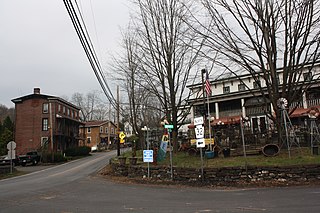
Point Pleasant Historic District is a national historic district located in Point Pleasant, Plumstead Township and Tinicum Township, Bucks County, Pennsylvania. The district includes 74 contributing buildings and 4 contributing structures in the riverfront and resort village of Point Pleasant. They include a variety of residential, commercial, and institutional buildings. The buildings are predominantly 2 1/2-story, stone and frame, gable roofed structures reflective of vernacular Greek Revival, Italianate, and Bungalow/craftsman styles. Notable buildings include "The Brambles," Thomas Schwartz House, Stover Mansion, Point Pleasant School (1850), Baptist Church (1852), Point Pleasant Hotel, Jacob Sutters Hotel, Waterman's Inn (1832), and the Stover Grist and Saw Mill. The contributing structures are four bridges that cross the Pennsylvania Canal.

Goshenville Historic District is a national historic district located in East Goshen Township, Chester County, Pennsylvania. It encompasses 11 contributing buildings, 2 contributing sites, and 2 contributing structures in the crossroads village of Goshenville. They date to the 18th and 19th century, and are reflective of a number of popular architectural styles including Greek Revival. They include residences, farmhouses, a tenant house, Goshen Friends Meetinghouse (1849) and burial ground, Hicksite Meetinghouse (1855) and burial ground, a general store and post office (1800), and a blacksmith / wheelwright shop.

Chester Springs Historic District, also known as The Old Art School, Orphan's School, Yellow Springs Spa, and Good News Buildings, is a national historic district located in West Pikeland Township, Chester County, Pennsylvania. The district includes 7 contributing buildings, 1 contributing site, and 1 contributing structure in the spa community of Chester Springs. The district includes the old hotel and inn, two large residences, a bath house at one end of the springs, and a studio. It also includes a wooden summer house that enclosed the iron springs. The property was the site of a hospital commissioned by the Continental Congress and built in 1777. The three-story, 106 feet by 36 feet wide building burned in 1902, was reconstructed, then burned again in the 1960s. The Yellow Springs resort operated in the early-mid 19th century and many of the buildings date from that period.
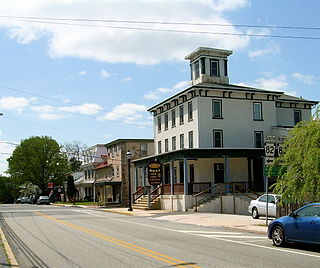
Elverson Historic District is a national historic district located in Elverson, Chester County, Pennsylvania. The district includes 133 contributing buildings, 3 contributing sites, and 4 contributing structures in the central business district and surrounding residential areas of Elverson. The district includes a variety of residential, commercial, and institutional buildings with examples of Bungalow/craftsman, Georgian, and Gothic Revival architecture. Contributing buildings date from about 1750 to about 1930. Notable buildings include "The Bank House", train station (1870), Springfield M.E. Church (1869), Blue Rock Hotel (1860), Dengler Bro. Store, Whoye Horse Tavern (1811), The Creamery (1906), and Springfield School (1873). One of the contributing structures is the railroad car "Baltimore County."

Northbrook Historic District, also known as Marshall's Mill and Marshall's Station, is a national historic district located in Newlin Township, Pocopson Township, and West Bradford Township, Chester County, Pennsylvania. It encompasses 14 contributing buildings and 3 contributing sites in the village of Northbrook. They are mostly located on five properties and built in the 18th and 19th century. They include the Blacksmith's house, station house, post office and store, coal and lumber company, Lewis Marshall house, Gothic Revival style Indian Rock Farm, Baily House (1902), Northbrook Sunday School (1900), and the site of Indian Hannah's cabin, Indian Rock, and Indian Burial Ground.

McConnellsburg Historic District is a national historic district located at McConnellsburg, Fulton County, Pennsylvania. The district includes 142 contributing buildings and 1 contributing site in the central business district and surrounding residential areas of McConnellsburg. The district includes buildings reflective of the Greek Revival, Georgian, and Federal styles. The buildings date between about 1762 and 1940, and include commercial buildings, institutional buildings, and residential buildings. Notable non-residential buildings include the Fulton County Courthouse (1852), Old Fulton County Jail, former Washington Hotel (1852), and former Albert Stoner Store (1893). The contributing site is the cemetery associated with the Methodist Episcopal Church. Located in the district and separately listed are the Fulton House and the log cabin of Daniel McConnell.
























